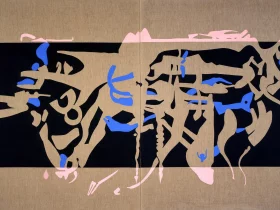Il vero nome di Helmut Newton (1920- 2004) era Helmut Neustädter (Newton è la traduzione quasi perfetta del nome tedesco in inglese).
Era infatti nato in Germania ma in seguito naturalizzato australiano. Muore nel 2004 in un incidente stradale a Hollywood, schiantandosi con la sua Cadillac contro il muro di uno dei più famosi alberghi di Los Angeles.
Si tratta di un artista che ha sempre profondamente diviso le opinioni di pubblico e critica. Considerato da molti uno dei massimi fotografi di sempre e da altri un sessista, un misogino (cit. Susan Sontag, 1979) le cui fotografie hanno “oltrepassato i limiti dell’accettabilità”, Newton è famoso in particolare per i suoi studi sul nudo femminile, e per l’uso esteticamente conturbante dell’immaginario erotico suggerito dalle sue immagini, che – sempre velate da un senso di vaga e inquietante perversione, e sempre impregnate di allusioni – spiazzano l’osservatore immergendolo in un gioco di rimpalli emotivi tra la glacialità della rappresentazione, spesso patinata e raffinatissima, e il contenuto non di rado fortemente esplicito.
Tra le centinaia di famosissime fotografie della sua produzione ce n’è una che forse meglio di tutte le altre sembra rappresentare l’essenza del suo gioco,: in un bianco e nero, leggermente mosso e vagamente sfocato per rendere l’idea del movimento, una figura femminile è rovesciata con le gambe aperte in posizione di lotta o di rassegnazione (o tutte e due), sotto l’impatto di un enorme cane nero il cui collo è adornato da un grosso e prezioso collare.
Le fauci del cane sono spalancate, gli occhi appena distinguibili. Ma tutta la postura dell’animale (leggermente defilata rispetto alle gambe della donna) genera il dubbio che si stia solo lasciando accarezzare, e che l’intera scena non sia che un gioco del quale l’autore stesso non vuole veramente conoscere la conclusione.
Helmut Newton è quello che ha detto:
«Bisogna essere sempre all’altezza della propria cattiva reputazione».
Ecco, io credo che con questa foto lo abbia confermato, aprendo, però, contemporaneamente la porta a sentieri ulteriori e molto più ampi dell’immaginario.
Sherlock Holmes, nel Mastino dei Baskerville (1893: terzo romanzo di Arthur Conan Doyle con protagonista il famoso detective) deve vedersela con quella che (apparentemente) è un’orribile creatura, che vive nella brughiera sotto forma digigantesco mastino. L’apparizione è particolarmente efficace nella famiglia Baskerville, in quanto rimanda ad una leggenda e ad una maledizione che risale a due secoli prima, quando un antenato degli attuali abitanti della tenuta venne sbranato da un cane “venuto dall’inferno”.
Holmes – che per l’occasione era stato niente di meno che resuscitato dal suo autore Arthur Conan Doyle il quale, stanco per l’insopportabile invadenza della sua creatura che, grazie alla fama acquisita, oscurava anche i suoi meriti letterari, l’avevo fatto morire in un episodio precedente – risolverà ovviamente il mistero, con acume e coraggio, come d’abitudine, svelandone la natura delinquenziale ma molto terrena.
Però è interessante questo girotondo di misteri e animali tenebrosi.
Nella tradizione britannica il “Black Dog” è una creatura notturna che ricorre nel folclore di tutte le popolazioni sparse sul territorio delle isole. Sono fantasmi ritenuti messaggeri dell’oltretomba, quindi di cattivo augurio. Vederli, secondo i vecchi, o anche solo sentire il rumore delle loro zampe, è segno che la fine è vicina.
Ma in fondo, in tutta la demonologia medioevale cani, caproni, gatti e altri animali, se neri, sono considerati emissari del diavolo.
E, se – da una parte – anche molti di noi, cittadini della modernità, non accettiamo senza un qualche disagio che un gatto nero ci attraversi la strada, dall’altra anche la letteratura recente continua a rifornirsi di elementi di questo genere, vedi Harry Potter e il prigioniero di Azkaban”, conoscendone il potere di impatto sull’immaginazione.
E le canzoni ? Basta citare Black Dog dei Led Zeppelin, che parla proprio di questi “mostri”.
Ma è consigliabile stare molto attenti, quando si avvicinano i cani.
Lo dice anche Orhan Pamuk: “Sono un cane e voi che non siete creature ragionevoli quanto me, dite che un cane non parla. D’altra parte sembra che diate credito a una storia in cui a parlare sono i morti e i protagonisti usano parole che non conoscono. I cani parlano ma solo a chi sa ascoltarli.” (O. Pamuk, Il mio nome è Rosso).
Quindi, ancora di più, bisognerebbe imparare ad ascoltarli. Attentamente.
Ne sanno qualcosa gli abitanti di Istanbul, che ancora narrano un’antica storia…
Nel 1910 Istanbul (che allora si chiamava Costantinopoli) era piena dappertutto di cani randagi . Non erano affatto animali cattivi, ma il governo Ottomano, per salvaguardare l’ordine e la pulizia, decise di eliminarli. E lo fece in un modo che desta orrore al solo pensiero: vennero tutti accalappiati brutalmente, ammassati in gabbie e traghettati fino a un isolotto deserto, dove “vennero completamente abbandonati al sole, senza acqua né cibo. L‘isola divenne famosa per il suo fetore percepibile da lontano. Migliaia di cani e uccelli si disputavano ferocemente le carcasse degli animali morti.” (dalle testimonianze dell’epoca di G. Goursat Sem). In più, in tutta la città nessuno riusciva a dormire perché il vento portava dappertutto nell’aria il lamento delle povere bestie, e in molti ebbero un qualche presentimento… Infatti, non molto tempo dopo la città fu devastata da un tremendo terremoto.
Da allora, Istanbul è nuovamente percorsa in lungo e in largo da moltissimi cani randagi, ma chissà perché nessuno più li tocca… e si avverte anche un certo senso di rispetto.
In tempi recenti, poi, un’iniziativa comunale (notevole, date le dimensioni ciclopiche della città) ha portato a realizzare una schedatura complessiva di tutti i cani che, ora, hanno un microchip inserito dietro un orecchio che li rende monitorabili e rintracciabili.
Tutti, forse anche quelli neri. Che però, come Helmut Newton, sono forse felici della loro cattiva reputazione e, di notte soprattutto, sfuggono a qualsiasi controllo e preferiscono camminare nei sogni più inquieti.
Black Dogs
The real name of Helmut Newton (1920-2004) was Helmut Neustädter (Newton is the almost perfect translation of the German name into English).
He was in fact born in Germany but later naturalized Australian. He died in 2004 in a traffic accident in Hollywood, crashing his Cadillac against the wall of one of the most famous hotels in Los Angeles.
He is an artist who has always deeply divided the opinions of the public and critics. Considered by many to be one of the greatest photographers of all times and by others a “misogynist whose photographs have exceeded the limits of acceptability”, Newton is famous in particular for his studies on the female nude, and for the aesthetically disturbing use of erotic imagery suggested by his images, which – always veiled by a sense of vague and disturbing perversion, and always imbued with allusions – displace the observer by immersing him in a game of emotional rebounds between the iciness of the representation, often patinated and refined, and the often highly explicit content.
Among the hundreds of very famous photographs of his production there is one that perhaps better than all the others seems to represent the essence of his game: in a black and white, slightly blurred to convey the idea of movement, a female figure is turned upside down with her legs open in a position of struggle or resignation (or both), under the impact of a huge black dog whose neck is adorned with a large and precious collar.
The dog’s jaws are wide open, the eyes barely discernible. But the whole posture of the animal (slightly offset from the woman’s legs) generates the doubt that he is only letting himself be caressed, and that the whole scene is only a game of which the author himself does not really want to know the conclusion.
Newton once said: “You must always live up to your bad reputation.”
Here, I believe that with this photo he confirmed it by opening, however, at the same time the door to further and much wider paths than the imagination.
Sherlock Holmes, in the “Baskerville Mastiff”, has to deal with what (apparently) is a horrible creature, who lives on the moor in the form of a giant mastiff.
The apparition is particularly effective in the Baskerville family, as it refers to a legend and a curse that dates back to two centuries earlier, when an ancestor of the current inhabitants of the estate was torn to pieces by a dog “from hell”.
Holmes – who for the occasion had been “resurrected” by his author Arthur Conan Doyle who (tired of the unbearable intrusiveness of his creature who, thanks to the fame gained, also obscured his literary merits) had killed him in a previous episode – will obviously solve the mystery, with acumen and courage, as usual, revealing its delinquent but very earthly nature.
But this circle of mysteries and dark animals is interesting.
In the British tradition the “Black Dog” is a nocturnal creature that recurs in the folklore of all the populations scattered on the territory of the islands. They are ghosts believed to be messengers from the underworld, therefore a bad omen. Seeing them, according to the old, or even just hearing the noise of their paws, is a sign that the end is near.
But basically, in all medieval demonology dogs, goats, cats and other animals, if black, are considered emissaries of the devil.
And, if – on the one hand – even many of us, citizens of modernity, do not accept without some discomfort that a black cat crosses the road, on the other hand also recent literature continues to supply itself with elements of this kind, see ” Harry Potter and the prisoner of Azkaban ”, knowing their impact on imagination.
And the songs? Just mention Led Zeppelin’s “Black Dog”, which talks about these “monsters”.
But it is advisable to be very careful when approaching dogs.
Orhan Pamuk also says it: “I am a dog and you who are not reasonable creatures like me, say that a dog does not speak. On the other hand, it seems that you give credit to a story in which the dead speak and the protagonists use words they do not know. Dogs speak but only to those who know how to listen to them. ” (O.Pamuk, My name is Red).
So even more, one should learn to listen to them. Carefully.
The inhabitants of Istanbul know something about it, and they still tell an ancient story …
In 1910 Istanbul (which was then called Constantinople) was full of stray dogs everywhere. They were not bad animals at all, but the Ottoman government, to safeguard order and cleanliness, decided to eliminate them. And they did it in a way that arouses horror at the thought: the dogs were all brutally huddled, piled up in cages and ferried to a deserted islet, where “they were completely abandoned in the sun, without water or food. The island became famous for its stench perceptible from afar. Thousands of dogs and birds fiercely contested the carcasses of dead animals. ” (from the testimonies of the time of G.Goursat Sem)
In addition, in the whole city nobody could sleep because the wind carried the lament of the poor beasts everywhere in the air, and many had some presentiment …
In fact, not long after the city was devastated by a terrible earthquake.
Since then, Istanbul has once again traveled far and wide by many stray dogs, but (who knows why?…) no one touches them anymore … there is also a certain sense of respect.
In recent times, then, a municipal initiative (noteworthy, given the cyclopean size of the city) has led to an overall cataloguing of all the dogs which, now, have a microchip inserted behind an ear which makes them trackable and traceable.
Everyone, maybe even the black ones. Who, however, like Helmut Newton, are perhaps happy with their bad reputation and, above all at night, escape any control and prefer to walk in the most restless dreams.
Marco Bucchieri (Roma, 1952) è uno scrittore, poeta visivo e fotografo, attivo sulla scena artistica fin dagli anni ’70. Il suo lavoro si concentra su simbolismo e allegoria, attraverso la realizzazione di mostre, installazioni di poesia visiva, immagini di valenza concettuale, e libri. Attualmente abita in provincia di Bologna, dopo aver vissuto in molte città italiane, a Londra e a New York.














lascia una risposta